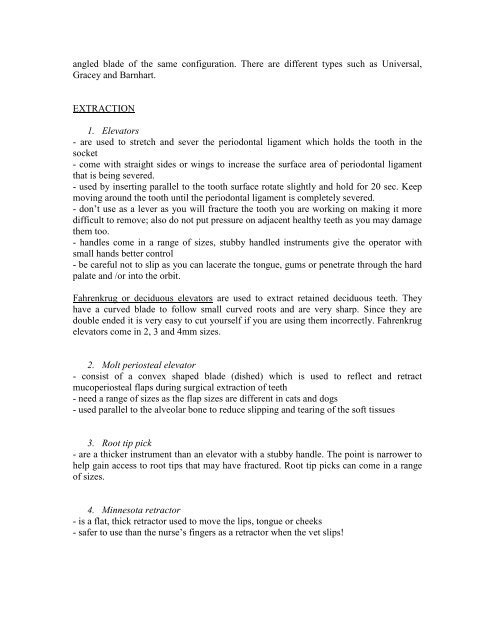Identification and Care of Veterinary Dental
Identification and Care of Veterinary Dental
Identification and Care of Veterinary Dental
You also want an ePaper? Increase the reach of your titles
YUMPU automatically turns print PDFs into web optimized ePapers that Google loves.
angled blade <strong>of</strong> the same configuration. There are different types such as Universal,<br />
Gracey <strong>and</strong> Barnhart.<br />
EXTRACTION<br />
1. Elevators<br />
- are used to stretch <strong>and</strong> sever the periodontal ligament which holds the tooth in the<br />
socket<br />
- come with straight sides or wings to increase the surface area <strong>of</strong> periodontal ligament<br />
that is being severed.<br />
- used by inserting parallel to the tooth surface rotate slightly <strong>and</strong> hold for 20 sec. Keep<br />
moving around the tooth until the periodontal ligament is completely severed.<br />
- don’t use as a lever as you will fracture the tooth you are working on making it more<br />
difficult to remove; also do not put pressure on adjacent healthy teeth as you may damage<br />
them too.<br />
- h<strong>and</strong>les come in a range <strong>of</strong> sizes, stubby h<strong>and</strong>led instruments give the operator with<br />
small h<strong>and</strong>s better control<br />
- be careful not to slip as you can lacerate the tongue, gums or penetrate through the hard<br />
palate <strong>and</strong> /or into the orbit.<br />
Fahrenkrug or deciduous elevators are used to extract retained deciduous teeth. They<br />
have a curved blade to follow small curved roots <strong>and</strong> are very sharp. Since they are<br />
double ended it is very easy to cut yourself if you are using them incorrectly. Fahrenkrug<br />
elevators come in 2, 3 <strong>and</strong> 4mm sizes.<br />
2. Molt periosteal elevator<br />
- consist <strong>of</strong> a convex shaped blade (dished) which is used to reflect <strong>and</strong> retract<br />
mucoperiosteal flaps during surgical extraction <strong>of</strong> teeth<br />
- need a range <strong>of</strong> sizes as the flap sizes are different in cats <strong>and</strong> dogs<br />
- used parallel to the alveolar bone to reduce slipping <strong>and</strong> tearing <strong>of</strong> the s<strong>of</strong>t tissues<br />
3. Root tip pick<br />
- are a thicker instrument than an elevator with a stubby h<strong>and</strong>le. The point is narrower to<br />
help gain access to root tips that may have fractured. Root tip picks can come in a range<br />
<strong>of</strong> sizes.<br />
4. Minnesota retractor<br />
- is a flat, thick retractor used to move the lips, tongue or cheeks<br />
- safer to use than the nurse’s fingers as a retractor when the vet slips!

















